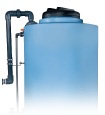There are many things to consider when choosing a chemical storage tank system. By the time the right tank and accessories have been identified, it’s time to order the tank and consider the international freight and logistics plan to get the equipment to you quickly, safely, in a cost-effective manner, and with little hassle or headache. Poly Processing Company works with companies all over the world and have a Director of International Sales dedicated to that business.
Topics:
Installation and Field Service,
Value Added
In this blog we look at how NSF/ANSI 61 certification differs by state and how that impacts tanks and drinking water components throughout the United States. Regardless of your geographic location, Poly Processing is committed to ensuring that our polyethylene storage tank systems are NSF/ANSI 61 certified. So no matter where you are, we can meet your state’s regulations.
Topics:
Certifications and Standards
Recently, with the help of a 3rd party leader in Polymer Engineering, we developed an enhanced OR-1000 resin. We've taken what we’ve learned in the field in the last 15 years and improved the material. Poly Processing’s exclusive OR-1000™ system was designed to address aggressive oxidation. We've recently developed a new enhanced version of the resin as an effective solution for your chemical storage needs.
In this blog we look at two types of plastic tank manufacturing, rotational molding and extrusion winding and explain how each process works and the benefits of a seamless (homogenous) tank for chemical storage. In polyethylene chemical storage tank manufacturing, there are a couple of popular processes to produce tanks. One involves rotationally molded tanks and the other is extrusion wound tanks. Each of these types of tanks are manufactured in a specific way. For some applications, the process by which a tank is manufactured is critical.
Topics:
Tank Design and Materials
We discuss the latest in polymer composite technology for storing strong oxidative chemicals like Sodium Hypochlorite, Hydrochloric Acid, and Sulfuric Acid. Poly Processing Company commonly uses high-density crosslinked polyethylene in our chemical storage tank construction. We use an engineered polyethylene called OR-1000 system inside of our crosslinked polyethylene tanks for heavy oxidizing chemicals, ensuring durable construction and an excellent antioxidant system.
Topics:
Tank Design and Materials
Technical specifications are one of the most important aspects of any project. And having clear specifications not only allows you to get a clear picture of what the expectations are but it also allows you to plan ahead.
Topics:
Value Added
The aspects of effective chemical storage tank design are often played out in real life, in a much less dangerous, yet still interesting, way.
Topics:
Fittings and Accessories,
Value Added
One of the biggest challenges in chemical storage tank design is achieving a full drain of the chemicals from the tank during regular operation as well as cleaning.
Topics:
Fittings and Accessories
NSF-61 Certification: Poly Processing is NSF-61 certified for Sodium Permanganate Storage.
Topics:
Chemicals
There are several measures taken during the shipping and delivery process in order to protect your investment in a chemical storage tank and its accessories. Poly Processing tanks ship directly from one of our three strategically located plant sites: Louisiana, California, or Virginia.
Topics:
Installation and Field Service



